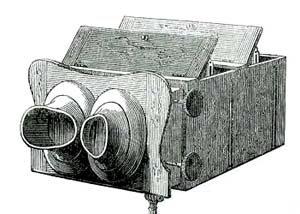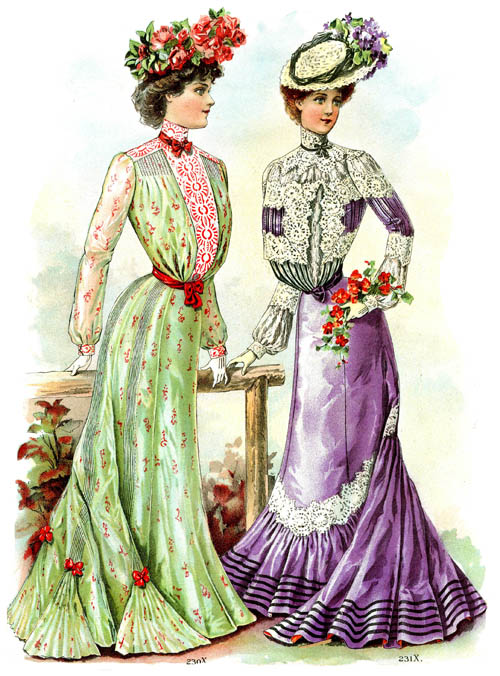|
Home > Victorian Science & Invention > Inventions > Developments in Photography

|
I admit it; the pun was intentional. (Although, perhaps, in another few years of digital photography, perhaps no one will even get it!) This section looks at scientific and technological developments in the field of photography, primarily for industrial and scientific use, as well as the development of X-rays. Articles on photography as a hobby can be found in the Recreation section.
|
- Improved Stereoscope
(Art Journal, 1853)
- A device for viewing a stereoscopic pair of separate images, depicting left-eye and right-eye views of the same scene, as a single three-dimensional image. (Think "Viewmaster" - you probably had one as a kid...)
- The Progress of Photography: Photo-Lithography
(Art Journal, 1853)
- "Photographic Pictures Etched on Metal Plates"
- Niepce de Saint Victor's Discovery of New and Remarkable Photographic Phenomena, by Robert Hunt
(Art Journal, 1858)
- Solar rays, chemical changes and phosphorescence.
- The Stereoscope and Its Improvements, by Robert Hunt
(Art Journal, 1858)
- The Stereoscope
(Cassell's Family Paper, 1860)
- The Photography of the Heavens, by William Huggins
(Cassell's Family Magazine, 1886)
- Recent Progress in Photography
(Century Magazine, 1882B)
- A camera designed to take photos of moving objects; a camera that uses field-glasses; microscopic photography; a new darkroom lantern; making prints on silvered glass; advances in photo-engraving.
- Petrography and the Microscope, by William Sloane Kennedy
(Century Magazine, 1884A)
- "The tool of the petrographer is the polarizing microscope, and his field of work the investigation of the intimate interior structure of rocks. The folk-lore tales have become true: we have magicians now who can look through the solid rock and tell you what lies hidden in its heart."
- Composite Photography, by John T. Stoddard
(Century Magazine, 1887A)
- In this case, composite photography is used to take portraits of several people from a particular group (e.g., a class) and combine them to create a single "representative" portrait of the group.
- Animal Locomotion in the Muybridge Photographs, by Talcott Williams
(Century Magazine, 1887B)
- A look at the famous photographs that first captured stop-motion sequences of movement (this article includes humans as well as "other" animals").
- Modern Amateur Photography, by F.C. Beach
(Harper's Monthly, 1889A)
- Aerial Photography, by Walter Woodbury
(Cassell's Family Magazine, 1890)
- Instantaneous Photographs, by Arthur Morrison
(The Strand, 1892A)
- Photographs capable of capturing motion.
- Edison's Invention of the Kineto-Phonograph, by Antonia and W.K.L. Dickson
(Century Magazine, 1894B)
- The kineto-phonograph was actually a form of movie projector.
- Some Curiosities of Modern Photography, by William T. FitzGerald
(The Strand, 1895A)
- A number of curious photos, including several used in the solving of crimes.
- Small Wonders of the Microscope, by William G. FitzGerald
(The Strand, 1896B)
- Submarine Photography, by Prof. Louis Boutan
(Century Magazine, 1898B)
- Wonders of the Polariscope, by Fred W. Saxby
(Strand, 1901B)
- The polariscope was used to detect and reveal the structures of microscopic crystals that could only be seen using polarized light. (Or something like that - it's complicated!)
- • See also Photography in the "Recreation" section.
-
- Marvels of the New Light: Notes on the Rontgen Rays, by H. Snowden Ward
(Windsor Magazine, 1896A)
- The New Photography, by Alfred W. Porter, B.Sc.
(The Strand, 1896B)
- Photographing the Unseen, by Thomas A. Edison
(Century Magazine, 1896B)
- A symposium on Roentgen Rays or X-Rays.
- What Are the X-Rays, by John Trowbridge
(Century Magazine, 1898B)
- The Rontgen Rays in Warfare, by Herbert C. Fyfe
(The Strand, 1899A)
- Using X-rays in military surgery.
|
Visit Our Victorian Shop
for:
Books
Coloring Books
Beautiful Spiral Journals
Holiday Greeting Cards
|
|


 Discover thousands of Victorian images in our
Discover thousands of Victorian images in our 